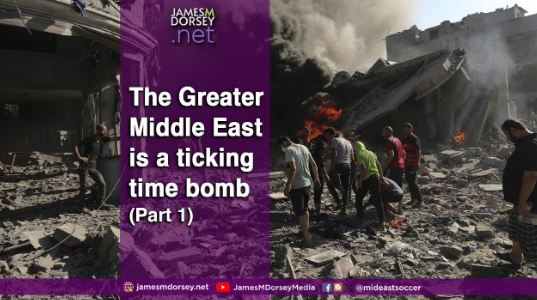JAMES M. DORSEY
The region’s most apparent powder keg – the risk of a regional conflagration between Israel and Iran that could draw the United States and regional countries like Lebanon, Jordan, Syria, Yemen, and Gulf states into the conflict – is foremost on policy and opinion makers’ minds. So is the war in Gaza with its devastating humanitarian fallout.
Yet, simmering at the surface in Gaza and across much of the Middle East and North Africa is social, economic, and political anger and frustration that could erupt at any moment but may not immediately manifest itself publicly.
This two-part series explores developments autocratic Arab rulers and US policymakers ignore at their peril. This two-part series explores developments autocratic Arab rulers and US policymakers ignore at their peril. The series is based on an essay published in Horizons.
Part 1 looks at the region as a whole as well as Hamas’ standing in Gaza eight months into the war. Part 2 focuses on the war’s potential fallout in Jordan, Saudi Arabia, and Egypt.
Scholars and analysts suggest public anger over the Gaza war could reverse youth disengagement from politics after two waves of mass anti-government protests in Egypt, Tunisia, Yemen, Iraq, Algeria, and Sudan that bookended the 2010s failed to produce real change.
Thousands rally in support of Palestine in Rabat, Morrocco. Credit: AFP
“Arab regimes have always been threatened by popular dissent, the Gaza carnage notwithstanding, but now they are pushing back harshly against public protests of their own citizens across the Arab world, including in Amman, Cairo, Manama, and Rabat,” said Emile Nakhleh, the retired founding director of the CIA’s Political Islam Strategic Analysis Program.
“Arab regimes are fearful that these pro-Palestinian protests that are denouncing the Israeli-inflicted destruction of the Gaza Strip and demanding a ceasefire could easily turn against them,” Mr. Nakhleh added.
Middle Eastern youth attitudes toward temporal and religious authority mirror youth approaches toward material concerns.
The younger generation’s world focuses on the individual rather than the collective, on ‘what’s in it for me?’ instead of ‘what’s in it for us?’
It is a world that is not defined by ideology or politics. It is a world in which the younger generation does not identify with the values and objectives espoused by elites and governments. In this world, the lingua franca differs substantially from the language in which the younger generation was raised.
Algerians demand change in 2019 protests. Credit: World Bank
“Arabs know what they want and what they do not want. They want their basic needs for jobs, education, and health care to be attended to, and they want good governance and protection of their personal rights,” said James Zogby, an Arab-American pollster with a decades-long track record of polling in the Middle East and North Africa.
Autocratic Middle Eastern rulers bet on economic development and transformation, producing vibrant and resilient economies that cater to youth aspirations. However, transitions are seldom a straight shot and are more often than not a process of two steps forward and one step back. In addition, there is no guarantee of success.
The consequence of failure “is truly daunting: a lost generation that feels some combination of disaffection and desperation, unable to escape stagnant economies, smouldering on the humiliation of losing both security and status from childhood,” said Middle East scholar Jon Alterman.
Mr. Alterman warned that in much of the Middle East and North Africa, “conditions may get worse before they get better.” He noted that countries forced to turn to international lenders for help would have to limit subsidies to already hard-hit middle classes.
Similarly, it is only a matter of time before wealthy Gulf states will have to reduce incentives intended to persuade youth to seek employment in the private sector rather than the government.
“The growing frustration among the Arab public against the injustice facing the Palestinians and the increased capabilities of the Iranian-backed non-state actors are the perfect recipe for chaos to erupt across the Middle East,” said Kuwaiti sociologist Mohammad Al-Rumaihi.
Generations in war-wracked Palestine, Syria, Yemen, and Sudan, and bankrupt Lebanon have little, if anything, to look forward to. Similarly, discontent is mounting and could explode anytime in countries like Jordan, Egypt, and Iran.
The carnage of the Gaza war has galvanized public opinion. Credit: CBC
Palestine is a pressure cooker and often catalyzes the expression of unrelated discontent elsewhere in the region.
Hamas’ attack on Israel on October 7 of last year and Israel’s response have returned the Palestinian cause to the top of the region and much of the world’s agenda and mobilized civil society in a swath of land stretching from Morocco on the Atlantic coast of Africa to Iraq.
In doing so, Palestine threatens to reignite anger and frustrations that have been building up for years.
“The region has failed to respond to the demands of its younger populations. This has left younger Middle Easterners more frustrated, angrier, and readier to reject the parameters of incremental change, growing more vocally towards complete upheaval and regime change, even with the failed uprisings of 2011 behind them,” warned political and development consultant Hafsa Halawi, more than year before the Gaza war.
Youth in Gaza has known little other than two decades of wars, blockades, and sieges. Beyond the trauma of the latest Gaza war, the Strip’s next generation is likely to experience at least a decade of a slow rebuilding of their lives that were shattered at birth.
“What will become of Gaza? Will we go back to work?… How will Gaza be rebuilt? Is the destruction too great? How long will it take? Will we live the rest of our lives without education and healthcare?” asked Gazan journalist Ruwaida Kamal Amer.
“Not a single university is left in Gaza. It will take years to rebuild the education system,” a senior United Nations Office for the Coordination of Humanitarian Affairs official noted.
Hamas spokesman Osama Hamdan discusses Hamas apology. Source: Facebook
Ms. Amer’s questions go to the core of mounting Gazan criticism of Hamas for provoking the Israeli assault that has devastated Gaza and reduced its 2.3 million inhabitants to destitution. The criticism, despite Hamas’ efforts to suppress expressions of dissent, does not mean that widespread support for armed struggle against Israel has diminished.
Nevertheless, Hamas felt compelled in March to issue a lengthy statement apologising to Gazans for their suffering. The group thanked Gazans for their resilience and acknowledged their “exhaustion.” It said it was trying to alleviate the “difficulties” Gazans faced by, among others, attempting to impose “price controls,” but its capabilities were limited “because of the ongoing aggression.”
Prices in Gaza have shot up astronomically, with, for example, 30 eggs that cost US$2-3 before the war selling for US35-40. However, prices have begun to drop with the recent increased flow of food into Gaza.
Hamas said it was discussing ways to “resolve the problems caused by the (Israeli) occupation” with other armed factions, popular committees, and “families,” a reference to clans that Israel has sought to engage in creating an alternative post-war governance structure for Gaza.
At the same time, the statement reiterated that the war would ultimately achieve Palestinian “victory and freedom.”
The statement suggests that criticism in Gaza has reached a level that worries Hamas, even if it is difficult to gauge public sentiment accurately. The Palestine Center for Policy and Survey Research produces what may be the only credible regular public opinion polling in Gaza and the West Bank.
Source Palestine Center for Policy and Survey Research
Fifty-two per cent of Gaza respondents to the Center’s latest survey said they favoured a return to Hamas rule as opposed to an administration by the West Bank-based, internationally recognised Palestine Authority, an Arab peacekeeping force, the United Nations, or Israel.
The Center’s polling suggested that Gazan public opinion was split on Hamas but left assessments of the strength of anti-Hamas sentiment to anecdotal evidence.
Ahmed Fouad Alkhatib, an anti-Hamas Palestinian-American who hails from Gaza, keeps close contact with the Strip and says he has lost 31 relatives in the seven-month-old Gaza war, described the complexity of evaluating the evidence.
“So many Gazans are forced to use aliases and hide their true identities when speaking out against Hamas & the horrendous impact of life under the Islamist group’s violent and authoritarian rule… Conformity is strictly enforced; differing views and alternative opinions will not be tolerated and could result in harassment, attacks, delegitimization, and even violence,” Mr. Alkhatib said.
Mr. AlKhatib’s portrayal likely speaks to the fear Hamas has instilled in Gazans since it took control of Gaza in 2006. While the group may be able to lash out at some critics since the war erupted, it’s hard to see how it can effectively impose its will while under Israeli assault and siege and hiding in underground tunnels.
Gazan hopelessness threatens to be the lightning rod for widespread social, economic, and political discontent across the Middle East and North Africa that could transition into militancy against the perceived double standards of the West as well as that of the region’s rulers.
Dr. James M. Dorsey is an Adjunct Senior Fellow at Nanyang Technological University’s S. Rajaratnam School of International Studies, and the author of the syndicated column and podcast, The Turbulent World with James M. Dorsey.

















